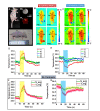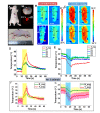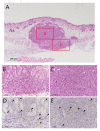Active thermodynamic contrast imaging for label-free tumor detection in a murine xenograft tumor model
- PMID: 29188098
- PMCID: PMC5695948
- DOI: 10.1364/BOE.8.005013
Active thermodynamic contrast imaging for label-free tumor detection in a murine xenograft tumor model
Abstract
Passive thermal imaging provides a limited differentiation between a tumor and neighboring tissue based on the temperature difference. We propose active thermodynamic contrast imaging (ATCI) with convection thermal modulators to provide more physiologically relevant parameters with high contrast such as the rate of temperature change, and thermal recovery time for tumor detection with a murine xenograft tumor model. With early stage tumors, we found the average rate of temperature change was higher in the tumor (0.22 ± 0.06 [Formula: see text]/sec) than that of neighboring tissue (0.13 ± 0.01 [Formula: see text]/sec) with heating modulation. With established tumors (volume > 100 mm3), this tendency was greater. On the other hand, the thermal recovery time was shorter in tumor tissue (τ = 7.30 ± 0.59 sec) than that of neighboring tissue (τ = 11.91 ± 2.22 sec). We also found distinct thermal contrast with cooling modulation. These data suggest ATCI is a potential tumor detection modality for clinical application with its inherently label-free and physiology-based approach. Furthermore, this strategy may find applications in endoscopic tumor detection in the future.
Keywords: (040.3060) Infrared; (110.2970) Image detection systems; (170.3880) Medical and biological imaging; (170.4580) Optical diagnostics for medicine.
Figures








Similar articles
-
Infrared thermal modulation endoscopy for label-free tumor detection.Sci Rep. 2024 Dec 30;14(1):31575. doi: 10.1038/s41598-024-76173-8. Sci Rep. 2024. PMID: 39738048 Free PMC article.
-
[Deeply cooled far-infrared thermal imaging strategy for early tumor diagnostics].Zhongguo Yi Liao Qi Xie Za Zhi. 2009 Mar;33(2):103-6. Zhongguo Yi Liao Qi Xie Za Zhi. 2009. PMID: 19565794 Chinese.
-
Extreme Insolation: Climatic Variation Shapes the Evolution of Thermal Tolerance at Multiple Scales.Am Nat. 2018 Sep;192(3):347-359. doi: 10.1086/698656. Epub 2018 Jun 22. Am Nat. 2018. PMID: 30125235
-
Infrared thermal imaging in medicine.Physiol Meas. 2012 Mar;33(3):R33-46. doi: 10.1088/0967-3334/33/3/R33. Epub 2012 Feb 28. Physiol Meas. 2012. PMID: 22370242 Review.
-
Quantitative Clinical Imaging Methods for Monitoring Intratumoral Evolution.Methods Mol Biol. 2017;1513:61-81. doi: 10.1007/978-1-4939-6539-7_6. Methods Mol Biol. 2017. PMID: 27807831 Review.
Cited by
-
Infrared thermal modulation endoscopy for label-free tumor detection.Sci Rep. 2024 Dec 30;14(1):31575. doi: 10.1038/s41598-024-76173-8. Sci Rep. 2024. PMID: 39738048 Free PMC article.
-
Focal dynamic thermal imaging for label-free high-resolution characterization of materials and tissue heterogeneity.Sci Rep. 2020 Jul 28;10(1):12549. doi: 10.1038/s41598-020-69362-8. Sci Rep. 2020. PMID: 32724184 Free PMC article.
References
-
- Diakides N. A., “Infrared Imaging: An Emerging Technology in Medicine,” IEEE Eng. Med. Biol. Mag. 17(4), 17–18 (1998). - PubMed
-
- Maldague X. P., Nondestructive evaluation of materials by infrared thermography (Springer Science & Business Media, 2012)
-
- Ng E.-K., “A review of thermography as promising non-invasive detection modality for breast tumor,” Int. J. Therm. Sci. 48(5), 849–859 (2009).
LinkOut - more resources
Full Text Sources
Other Literature Sources
